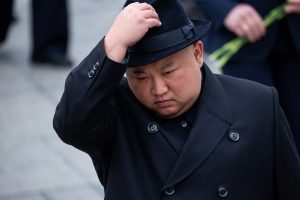In December 2023, North Korean leader Kim Jong Un outright rejected the idea of reunification with South Korea. Kim argued that North-South relations were no longer relations between compatriots, but were instead a “hostile relationship,” and that South Korea should not be seen as offering the potential for reconciliation or unification. In taking this stance, North Korea unilaterally repudiated the consensus reached by the two Koreas in 1991, which held that they shared “a special relationship constituted temporarily in the process of unification, not being a relationship between states.”
North Korea’s policy was laid out in more detail during a policy speech delivered in January 2024, in which Kim ordered that the slogan of “independence, peaceful unification, and great national unity” be struck from the North Korean Constitution, and that South Korea be designated as the “number one enemy and unchanging main enemy.”
Korean unification had been a national policy since the days of Kim’s grandfather Kim Il Sung, and so its abandonment represents a major policy shift. However, while Kim’s decision may seem extreme at first glance, it is arguably also realistic. North and South Korea are separate members of the United Nations, and have long been operating as effectively separate nations.
In fact, the biggest shock from the about-face on unification may have been felt by Koreans living in Japan, known as Zainichi Koreans. Up to the end of World War II, Japan had occupied the Korean Peninsula for decades, by which point some 2 million Koreans were living in Japan. The end of the war, and of Japan’s empire, meant that these Koreans lost their Japanese nationality. Meanwhile, reflecting the conflict between North and South Korea, they formed two distinct groups, the Korean Residents Union (KRU, “Mindan”) made up of those who supported the South Korean government, and the General Association of Korean Residents in Japan (known as “Chongryon”), whose members supported the North Korean regime. During the Cold War, Chongryon wielded the most organizational power, and its members set about establishing ethnic schools for their children, ranging from kindergartens to the university level. They also established credit unions to support their members.
As Japan and South Korea began to earn international recognition after the war, the number of Zainichi Koreans obtaining Japanese or South Korean citizenship increased, and Chongryon membership is now less than 100,000. However, for those Zainichi Koreans who remain members, leaving the organization is not easy, even if they harbor misgivings about the North Korean government. This is partly due to concerns that doing so may have negative repercussions for family members living in North Korea.
Between 1959 to 1983, more than 90,000 Zainichi Koreans returned to North Korea, the largest population shift from a capitalist country to a socialist country in history. Those who were seduced into living in North Korea by the “Paradise on Earth” propaganda campaign found themselves facing extreme poverty, lacking adequate food, clothing, and shelter, and being forced to beg for money from relatives who remained in Japan. Zainichi Koreans have continued to send money to North Korea, sardonically referring to returnees as “hostages.”
During the period when North Korea’s stated goal was unification, Zainichi Koreans who belonged to Chongryon were able to engage with South Koreans. South Korean President Moon Jae-in even allowed Chongryon-affiliated Zainichi Koreans to enter South Korea without a South Korean passport.
However, now that the North Korean government has begun enforcing Kim’s new policy even with respect to Chongryon-affiliated Zainichi Koreans, they face new concerns, such as the possibility that in the future they will no longer be able to visit friends and family in South Korea. Meanwhile, with unification completely off the table, they can’t even use maps depicting the entire Korean Peninsula in their ethnic schools. To make matters worse, ethnic schools operated by Chongryon include both students and teaching staff whose nationality is South Korean, North Korea’s sworn “number one enemy.”
Kim’s rejection of unification was not a sudden announcement. When the “Our State First” slogan emerged in 2017, there were signs of a shift in emphasis from ethnicity to nationalism. Last year North Korea’s Ministry of Foreign Affairs announced it would prohibit South Koreans from entering North Korea. Meanwhile duties that had previously fallen under the jurisdiction of agencies that liaise with South Korea, such as the United Front Department of the Workers’ Party of Korea, were transferred to the Ministry of Foreign Affairs, signifying that North Korea now regards South Korea as it does other foreign countries. Some observers speculate that this stems from a desire to root out interference from South Korea and defend the northern half of the Korean Peninsula as its own dynasty.
Kim’s administration enacted new legislation with the Reactionary Ideology and Culture Rejection Act and Pyongyang Cultural Language Protection Act, in 2020 and 2023 respectively. These laws place strict prohibitions on exposure to South Korean culture such as K-pop and television dramas, as well as the use of colloquial “puppet” Korean spoken by people in Seoul. North Korea is increasingly wary that an influx of South Korean culture could destabilize the regime.
Another key development that is that North Korea has made it known, both internally and externally, that it will not hesitate to use military force against South Korea. Since South Koreans are no longer considered a compatriots, this sends the message to North Korea’s own citizens that the North is prepared to attack if necessary. It is also seen as means of deterring both South Korea and the United States.
For many years Chongryon-affiliated Zainichi Koreans have been manipulated by their homeland, and have continued to send money to their relatives being held hostage in the North. Now, however, they find themselves caught up in a new political maelstrom.

































